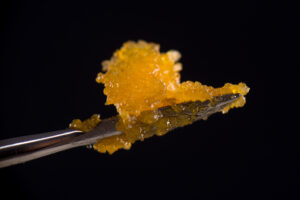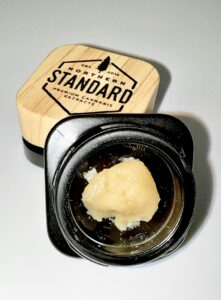Let’s first break down the term “live”. Live concentrates are made from plants that are still alive, meaning the material is harvested and immediately extracted – the biomass is never cured or dried. Cured dry flower is great for combustion – for example, burning it in a joint or bowl – but for making concentrates, freshly harvested flower that is never dried or cured will produce a superior extract. This is because the curing process evaporates volatile monoterpenes as the flower dries, cleaving the natural terpene spectrum and reducing its overall content of flavor and aromas. And, during drying and curing, cannabinoids like THCa decarboxylate to THC.
Smoking THC differs from THCa in that when THCa decarboxylates it loses a CO2 molecule. So, when you take a dab or a hit from a vape pen with very high THCa, as it’s heated the vapor decarboxylates, releasing the CO2. The CO2 that is released acts as a propellant for the THC and forces it deeper into the vascular tissue of the lungs and throat. This way people who use live concentrates always say it is more psychoactive and they feel the effects quicker.

The same is true with alcohol. Carbonated alcoholic drinks hit harder than non-carbonated ones, because of the propulsive action of the CO2 being released.
Now, what’s the difference between Live Resin and Live Rosin? The answer is: the use of solvent during the production process.
Resin is extracted with the use of a solvent. Solvents are efficient in removing curative compounds from plant material. Once they are dissolved into a solvent the plant compounds are then separated and purified, then the solvent is removed from the extract leaving a high purity concentrate. Most companies producing live resin use toxic hydrocarbon solvents like propane and butane. We do not. We only use CO2 and ethanol to produce our live resin. This ensures that there are no harmful toxic residuals in the product.
Rosin production does not use any solvents. The fresh, live plants are submerged in freezing ice water. After about fifteen minutes in an ice water bath, the trichome heads (where all the cannabinoids and terpenes are) will become brittle and with a small amount of agitation, they break off and fall to the bottom of the ice water bath. They are then drained into a variety of filter bags separating the trichome heads. Under a microscope, these look like clear glass balloons with droplets of amber oil inside. The oil inside the gland head is what we are after.

The trichome heads are collected from the bags and placed in a freeze dryer to sublimate the water while the trichomes remain frozen. After all the water is removed the trichomes are placed into another filter bag and gently pressed through the filter. The combination of heat and pressure ruptures the trichome, or gland head, and releases the oil inside of the trichome from the glass-like bulb it is enclosed in. The oil is collected and then cured in a cold chamber for about two weeks. The cold-curing process allows the terpenes to permeate the oil and creates a homogenous buttery-like matrix that can be easily dabbed or placed into a vape cartridge.
